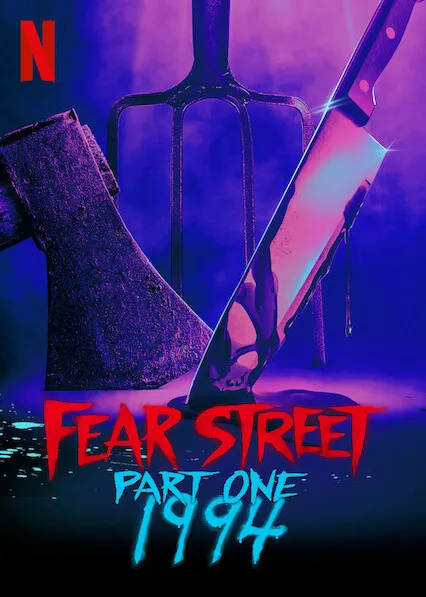This story contains spoilers for “Fear Street Part One: 1994.”
“Fear Street Part One: 1994” premiered in the teen slasher horror genre on Netflix on July 2, quickly rising to the top of Netflix’s Top 10 charts worldwide. The film is the first installment of a trilogy; Netflix released the second movie, “Fear Street Part Two: 1978,” on July 9, and the third, “Fear Street Part Three: 1666,” on July 16. Director Leigh Janiak told Deadline that the decision to release the episodes of the trilogy in rapid succession makes the series “a hybrid of traditional television content and movies.”
The movie is set in two fictional neighboring towns in Ohio: Shadyside, the murder capital of the United States, and Sunnyvale, one of the safest and most affluent towns in the country. The urban legend among the Shadyside residents is that in 1666, the witch Sarah Fier cursed the town before she was executed for witchcraft.
The movie’s protagonist, Shadysider Deena Johnson, does not believe in the curse. In contrast, her younger brother Josh spends all his time online researching the town’s many murders and their connection to the witch. Other major characters include Deena’s friends, Simon and Kate, and Deena’s ex-girlfriend Sam. Simon and Kate sell drugs to support their families, while Sam’s family has recently moved up the socioeconomic ladder and to Sunnyvale.
Following an altercation between some Shadyside and Sunnyvale teens, Sam is involved in a car crash and unknowingly disturbs the witch’s grave. Throughout the movie, the group is haunted by the witch’s curse and undead killers from Shadyside massacres. Their attempt to escape the witch and cheat death is equal parts exciting and terrifying.
I enjoyed the film mostly because it uses the complexity of the characters to avoid the cliches of the teen slasher horror genre. For example, the movie’s portrayal of Deena and Sam’s relationship brings up the issues of social-class differences and prejudice — Deena is aware that her relationship with Sam breaks traditional cultural norms. The characters are also still trying to figure out who they are at different points in their journeys of self-discovery. As Nivea Serrao, who wrote for Syfy, said, “While Deena is more out and proud of who she is, Sam is not at all open about it.”
Couples in teen slasher movies often fall under the same trope; they have been together for years, fight over a stupid thing, make up and then either live or die. Unlike Deena and Sam, these cookie-cutter couples seem to have everything in their personal lives figured out and do not explore their identities. Meanwhile, Deena and Sam are not only trying to survive a horror movie, but also trying to find their place in the world as young queer women.
Simon and Kate are also more nuanced than your standard horror movie supporting characters. They are known throughout the town as druggies and teenage dirtbags. Instead of using the Hollywood trope of bad kids, however, the movie expands on these two. We learn that Simon is the main provider for his family, and that Kate is an overachiever who hopes to land a college scholarship and leave Shadyside. This character development makes the two more likable and sympathetic, and ultimately their eventual gruesome murders are even sadder.
Even so, the movie isn’t perfect. One of my criticisms: Deena’s behavior at the end of the movie is bizarre. After Deena, Sam and Josh are the only ones that make it through a bloody showdown in a supermarket, Deena and Sam publicly come out as a couple. Even though Deena has just seen her two best friends murdered, she seems totally content. It’s weird, to say the least, and the audience doesn’t see her grieve at all. Perhaps the writers wanted to wrap up Deena’s storyline with Sam such that the viewer remains hopeful they can now be together in peace — but it all feels a little forced.
Deena isn’t the only character in the film to react strangely to a death. The movie begins with a murder in a Shadyside mall after dark. The victim is a young bookstore employee and student at Shadyside High School. At school the next day, none of the Shadyside students seem to care at all. Some of them, including Simon, crack jokes about the murder, and do so even at the victim’s vigil that night. The nonchalance and joking seem to have been meant to convey how normalized murders are in Shadyside, but instead it just makes the characters seem like emotionless jerks.
Another shortcoming is the way that the movie navigates the time period. The film is set in the ’90s. In contrast to works such as “Stranger Things,” however, the time period barely plays a role. In “Stranger Things,” small cultural references such as New Coke and “Ghostbusters” are nostalgic and enhance the story. These types of details are pretty much absent from “Fear Street.” Erik Cain from Forbes said it well: “The film never really feels like the ’90s.”
Regardless of the movie’s faults, the ending (which I don’t want to spoil) is shocking; a twist involving our surviving characters sets up the sequel very well. The second film is set in a camp in 1978, where a massacre occurs. The sole survivor of that massacre already interacted with our gang in part one, so it will be interesting to see how her story connects to the one in 1994.
Overall, while the film does have its faults, it is an enjoyable watch, and the fact that the movie is part of an interconnected storyline makes it all the more intriguing. Hardcore horror movie fans will probably find this movie to be child’s play, but for the down-to-earth horror fans who get scared easily, this movie will cause quite the scream.
